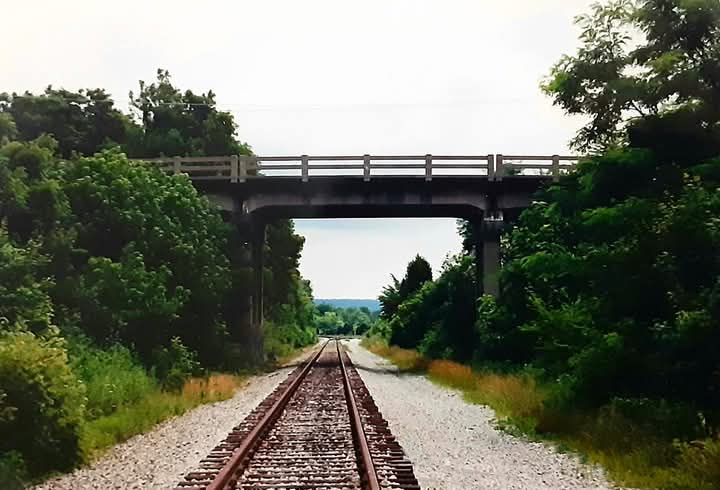STORY #40
PEEBLES AND THE VIADUCT
The Interstate Commerce Commission became the first federal independent regulatory agency to be established in the United States. It was created with the Interstate Commerce Act of 1887 to regulate the railroad industry by establishing fair rates, by eliminating discriminatory practices and by providing supervision over other aspects of common carriers. The group's jurisdiction grew to include additional forms of interstate transportation such as trucking, buses, water carriers and pipelines.
In 1945, the Commission issued a report that strongly encouraged improvements to railroad systems. The group had looked at 971 accidents occurring that year. Most involved a vehicle running into the side of a train. While 354 accidents were at crossings protected by lowered gates, watchmen, trainmen or audible and visible signals, there were 617 at crossings equipped only with stop signs or warning signs.

The Norfolk and Western Railroad had experienced its share of preventable incidents and soon after receiving the report, began major projects to upgrade its various rail divisions, not necessarily, however, for safety reasons, but under the cause of providing “speedier and more efficient movement of traffic.”
The company announced plans in the early summer of 1946 to spend approximately $3,000,000 on its rail system between Portsmouth and Cincinnati, specifically focusing on the area from Peebles to the east.

Advances in electrical engineering paired with radio frequency technology led to a number of immediate improvements. In particular, a “centralized traffic control” utilizing radios and electronic switching was installed at the dispatch office point in Portsmouth.
It was considered a foolproof remote management apparatus that would increase railroad safety performance and simplify operating capabilities by eliminating the practice of using traditional written train orders passed from person to person. A single dispatcher was given complete control over routing trains along 96 miles of track.
Several projects involved changes to the existing rail configuration. Four and a half miles of track was straightened between Mineral Springs and Plum Run. Two and a half miles was regraded between Plum Run and Peebles. A steel and concrete bridge six hundred ninety feet long was built over the the Cedar Fork Creek and valley.
The design called for eight sixty-foot spans and seven thirty-foot spans raising to a height of seventy feet. Another new bridge was constructed over Scioto Brush Creek, thirty feet high and three hundred sixty-five feet long. A curve in another section of track was relocated to eliminate the need for two bridges to cross a winding creek in the Plum Run area.
N. & W. also partnered with the Ohio Department of Transportation in supplying workers and materials to straighten and improve much of the rail line along what was then Routes 73 and 74 to the east. The roadway paralleling the railroad tracks was relocated with construction of a new two hundred foot bridge.
A dangerous curve on a connecting road was eliminated, and nine thousand feet of narrow, winding highway was relocated and widened.

From the beginning there was a strong relationship between the railroad and the stone business known under a number of names: the Basic, The Davon Corporation, Plum Run Division, etc. The company was a major producer of crushed stone in various sizes for road building, ballast, cement and other uses, and the railroad was a major shipper. The company also produced agricultural lime for farming and rock dust for coal mines. The crushing plant was one of the most efficient in the country, grinding all stone to exact specifications. The screening plant is at the top of the picture from 1959.

Of most importance to the residents of Peebles, an overhead crossing was built at Nixon Avenue, thereby eliminating the normal grade crossing in use at that location (formally a viaduct, locally pronounced as vi-uh-dock). Valued N. & W. patrons in the village included Neill and Breslau, dealing in pulpwood, hardware, feed and appliances; Haas Lumber Company, with an extensive variety and supply of building materials; Adams County Farm Bureau Cooperative, supplying seeds, grain and fertilizer, a variety of feed, bulk farm supplies; and Steve Greene, shipping railway ties and timber.
When deliveries were being made or products from the area loaded onto rail cars, it was often necessary to block the railroad crossing at Main Street for an extended period of time. In earlier times, If emergency crews were needed across the tracks, they would have to wait while the train shuttled cars enough for an open crossing. It was also unhandy for school buses loaded with children to wait for their turn. With access over Nixon Avenue it was easier to avoid delays. The viaduct later became a great asset every year as the downtown area was, and still is, closed off for Old Timer's Days.

Same Boy, Same Wagon, New Bridge...

Back in 1946, a MAGAZINE photographer while at Peebles, Ohio, taking pictures of the Cincinnati line improvements then under construction, snapped a picture looking north along Nixon Avenue toward the railroad crossing soon to be eliminated with an overpass.
In it appeared a small boy, industriously pumping a small wagon down the road. Last month, when the photographer returned to take a picture of the completed overpass, he found the same young man pumping the same wagon at the same place.
The boy is Larry Hoop, son of Denver Hoop, Jr., carpenter on the Scioto Division, who worked as axeman when the preliminary line was run for the westbound track from Mineral Springs to Peebles. Larry's grandfather, Denver Hoop, Sr., was for many years section foreman at Peebles.
(MAGAZINE was a publication of the Norfolk & Western Railroad)
